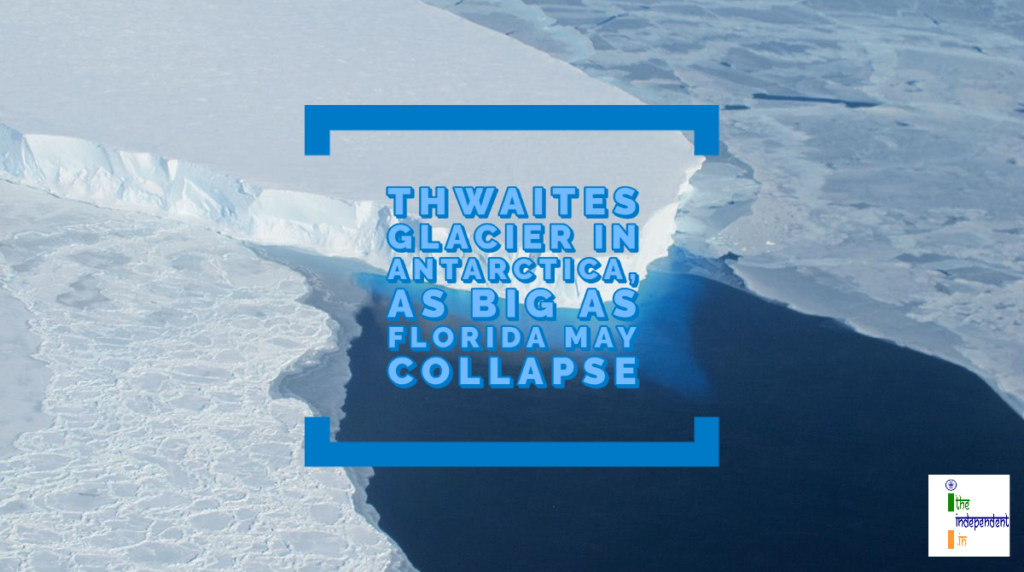
Thwaites, the widest glacier on earth, which is also known as Doomsday Glacier, is melting at a fast pace due to warm water channels under surface, responsible for dumping billions of tonnes of ice in the ocean every year and pushing up global sea-levels.
If Thwaites in Antarctica, which is around the size of Florida or Great Britain, were to collapse, it could lead to an increase in sea levels of around 25 inches (65 centimetres).
Back in 1990s, the glacier was losing around 10 billion tonnes of ice each year. Today it is losing 80 billion tonnes of ice. It is referred as “doomsday glacier” because it is one of Antarctica’s fastest melting glaciers. The melting of ice in this giant mass of ice accounts for around 4% of the planet’s annual sea-level rise.
Thwaites Glacier (75°30′S 106°45′W) flows into the Pine Island Bay, part of the Amundsen Sea, East of Mount Murphy, on the Walgreen Coast of Marie Byrd Land. Its fastest flowing grounded ice is centred between 50-100 kilometres East of Mount Murphy.

The Background
The United States (U.S.) based National Science Foundation (NSF) and United Kingdom (U.K.) based Natural Environment Research Council (NERC) have entered into a partnership, called International Thwaites Glacier Collaboration (ITGC), where researchers from both the countries are studying the rapidly changing glacier.
A series of missions undertaken by ITGC found that sea channels underneath the glacier were far deeper than previously thought.
These channels are upto 600 metres deep, equivalent of 6 football pitches back to back. The scientists are now finding out how soon this disaster may happen.
The British and American researchers from ITGC project began collecting data from the glacier and adjoining ice shelves last year. While one team collected airborne data flying over the glacier and ice shelf in a British Antarctic Survey Twin Otter aircraft, the other mapped the sea floor at the ice front from the U.S. Antarctic Program’s icebreaker vessel RV Nathaniel B Palmer.
Dr. Tom Jordan, an aero-geophysicist from the British Antarctic Survey (BAS) who led the airborne survey said, “I was shocked to fly over the glacier and see all the debris left behind as the ice shelf has collapsed – it was stunning.”
He further said, “You look out the window and you see the broken-up fragments of the former ice shelf. It was breathtaking. It brought home how much how much this natural system has been damaged and is breaking up.”
Dr. Jordan also stated that the carbon emissions from human activity have contributed to the warming of the ocean in Antarctica.
Another scientist from BAS – Dr. Kelly Hogan shared, “These channels had not been mapped before in this kind of detail, and what we’ve discovered is that they’re actually much bigger than anyone thought – up to 600m deep. Think of six football pitches back to back.”
Present Scenario
Presently, the eastern side of the Thwaites Glacier is hooked on to a large ridge, which gives it stability. But the rapid rate of melting will not make it sustain longer. When the Eastern Ice Shelf will be detached, the ice will spread out and thin and will eventually break up.
What’s next?
The present information available with researchers refines the volumes for ingressing warm water that can be considered possible under different scenarios. The research conducted by scientist will be more meaningful as now they can run simulations of possible future behaviour and get realistic outcomes. The scientists also now have a better idea of the general roughness of the seafloor.
Meanwhile, ITGC is undertaking several studies that strive to create a better forecast of the glacier’s retreat and explore conditions that could lead to a rapid increase in ice loss. These are:
- TIME: This is a study of how the boundary of the glacier evolves and what are the differences between the slow-moving ice, underlying rock outside the glacier versus the interior.
- GHOST: It is a traverse of the core of the glacier, looking at ice and bedrock characteristics with seismic and radar data.
- GHC: It will collect rock samples from either side of Thwaites Glacier to look for clues as to its recent past history.
- THOR: This will include bathymetric mapping and oceanography using marine sediments.
- MELT and TARSAN: These will study the ice-ocean interaction at the point of contact between land, ice and sea. It will also include ocean circulation and rates of ice melt near the front of the glacier.
COVID-19 and the study
Unfortunately, the ongoing research in Antarctica is on hold. It was stopped in March 2020 owing to the Coronavirus (COVID-19) outbreak. It will remain on hold till 2021.
The Big Hope
Once the research resumes, the study will help build a better understanding of the glacier and its environment, and transmit that new knowledge to the public, the wider science community, and policymakers.

